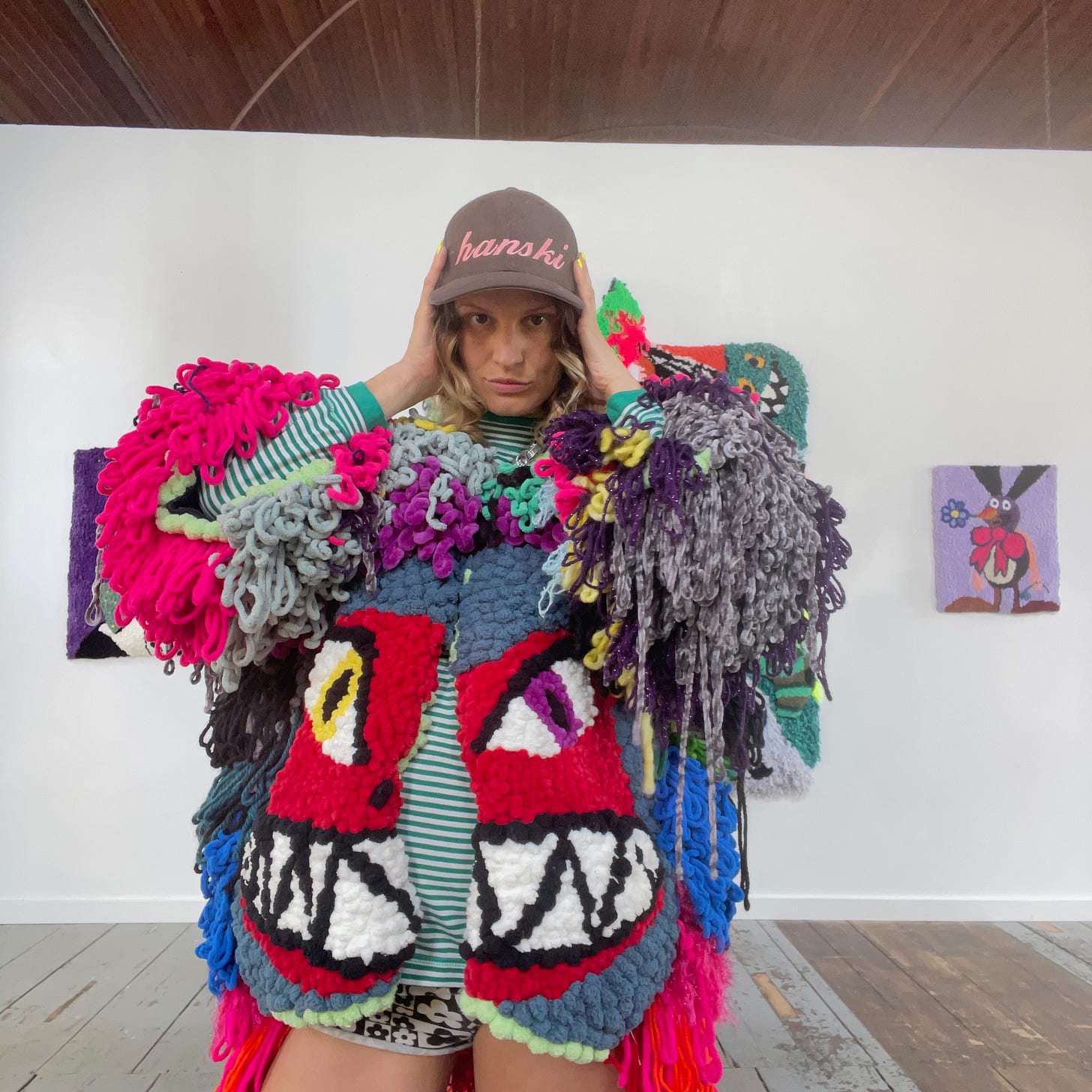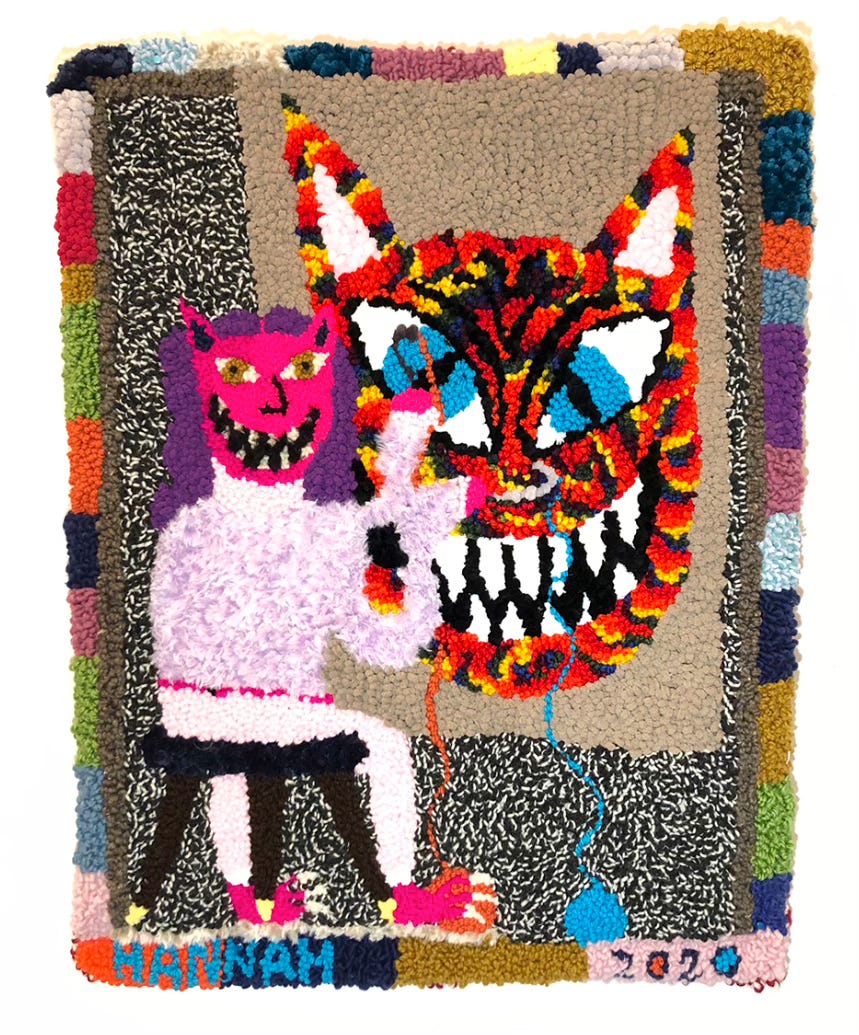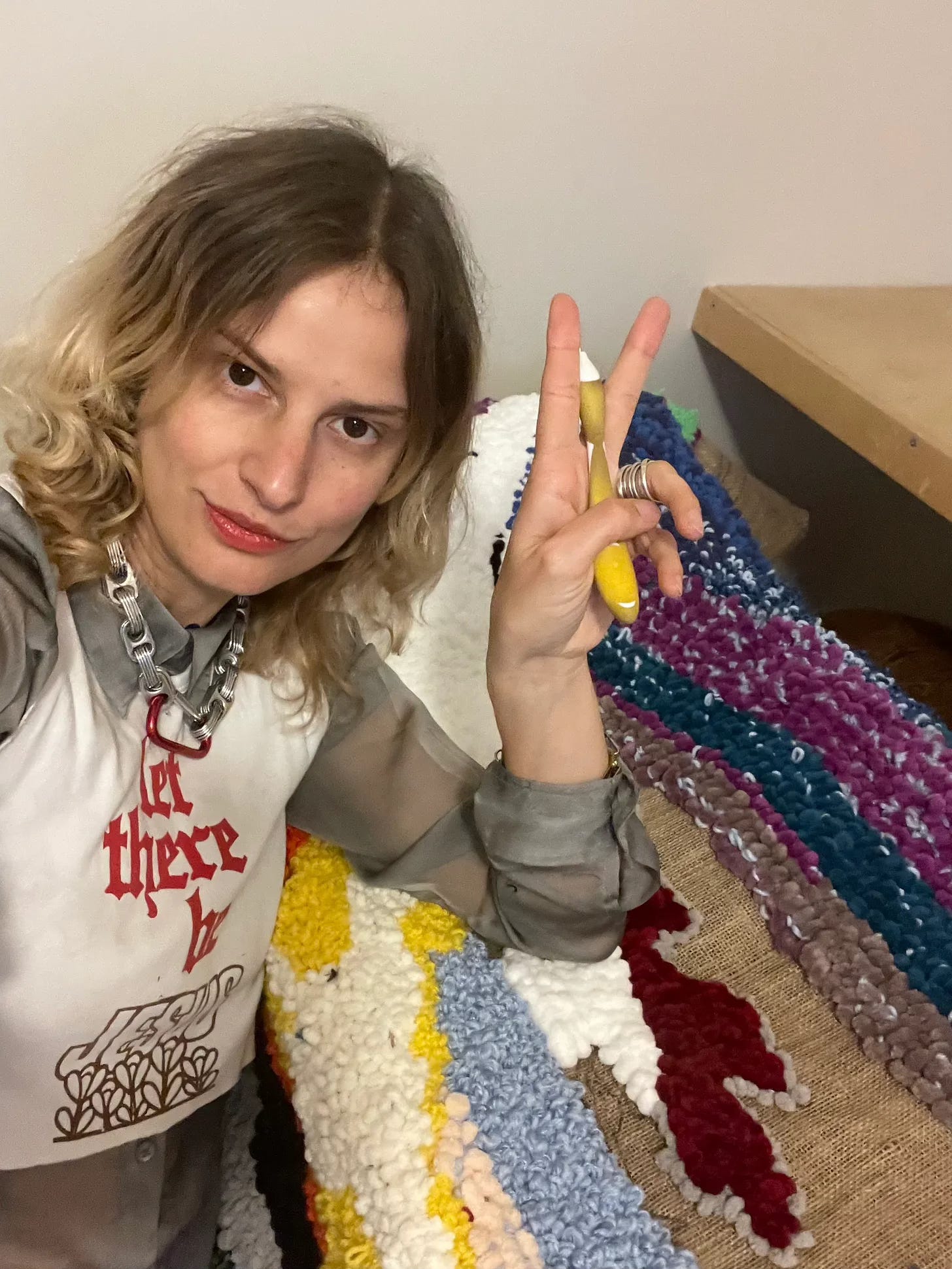Hannah Epstein
The self proclaimed 'feminist folklorist of the Internet Age' discusses being raised in a house of women, Brittany Spears and becoming a ‘new hooker'
Hannah Epstein (AKA Hanski) is a Canadian pulp artist. Working with a wide array of media, she collects and reforms populist narratives related to the banal and personal moving through the techno-empire of the 21st century.
Hanski’s work has been exhibited in prestigious institutions such as The Hammer Museum, Arsenal Contemporary and The Art Gallery of Ontario and is in the collections of notable figures such as Jorge Perez, Beth Rudin DeWoody and Demi Lovato.
Mepaintsme: To get started, it would be great to learn about your background. Could you talk a bit about where you grew up, and your family history?
Hannah Epstein: Although I was born in Toronto, ready from birth to be nurtured in one of Canada's few big cities (there are three), and become the cosmopolitan woman I was meant to be, my parents split up — the result of my father's affair. As a result, my mother ripped me from the multicultural streets of Toronto and moved us, sans father, to Halifax, a small east coast town that some daringly call a "city".
There, I was raised in a house of women. My Latvian grandmother, AKA "omi", my mother, and my eleven-year-older sister from my mother's first marriage, made up the matriarchy of my childhood. They were all strong, opinionated women, and as models for what womanhood looked like, I was instinctively repulsed. The only male presence in the home was my younger brother, a soft and gentle person, an "old soul".
MPM: That sounds like a pretty intense environment to grow up in! Did you find some more relatable influences in school?
HE: In school, I was very much a tomboy. All I wanted to do was play sports and that's what I did, always the only girl in a large company of boys. I loved the competitive spirit and the camaraderie I found with these boys and resented the sideline girlishness of my female peers.
By this point, my father had abandoned his relationship with the "other woman" and had bought the house directly around the corner from my mother — so close they shared a backyard. I remember the momentous day they took the fence down between the two backyards, joining it into one. My own personal Berlin Wall moment.
Through most of my childhood and adolescence my parents were in an open relationship of sorts. Some nights they would meet up to watch Masterpiece Theatre and other nights my father would host my brother and I for dinner at his house, always a new girlfriend present to break the tension. Or add it, I'm not sure.
MPM: That must have been a lot to make sense of as an adolescent.
HE: It was — as I was physically divided between two places, my mother and father's houses, I was also culturally torn. I was an odd mix. The Latvian side of my family had escaped the Communists and my omi always blamed the Jews for having created the ideology. Meanwhile, my father was Jewish, though non-practicing outside of some of the high holiday gestural rituals. This left me oscillating between many states of being, many histories, and without true place within any of them. I credit this experience for creating a betwixt-&-between mindset that keeps me skeptical of any group of tribal affiliation.
Anyway, I hated where I grew up. Everything felt small and dumb and irrelevant next to all the US television I obsessively watched. My motive, once my resentment hit a crescendo, was nothing other than escape. And I did, I left when I was seventeen.
MPM: You have an undergraduate degree in Folklore and Religious studies. What drew you to these subjects?
HE: When I started my B.A, it was strategic in that my grand aspiration was to become a writer.
I was young and inexperienced and knew I was incapable of writing anything of note, so, I decided that before I undertook any major writing project, I had to learn what a story truly was and how narratives function within social contexts. I wanted to answer: “WHY tell a story?”. Folklore was the perfect path in regards to answering this question. It was all about examining unofficial contemporary narratives and learning to read the subtext. The Religious Studies aspect ties in as sanctioned myths and coded anecdotes protected by some concept we have of "holy" and "god". Where Folklore and Religion intersect there a lot of thick, juicy, story-meat, and I was feasting.
After I finished my first degree, I decided that the next step was to live an exciting life in order to have something to write about. So, I spent the next ten years running around, spending 3-4 months in different cities, slowly gnawing away at my youthful ecstasy and ignorance, of which I had much.
MPM: So art hadn’t even entered the conversation yet! When did it? I know you earned an MFA from Carnegie Mellon University in Pittsburgh — was this when you started creating art? What was your focus of study there?
HE: It was in an RV park just outside of Death Valley in 2009 that I had my epiphany — I realized that if I wanted to tell stories in the modern moment, I would have to delve into technology. That eventually led me back to the city of my birth, Toronto, where I fell in with the indie games community. As an independent, experimental game designer, I was starting to create and tell stories in my own style — accidentally I was creating a portfolio and dialoguing with the tech side of the art world. So, I basically back-doored my way into the MFA program at Carnegie Mellon, a school that officially recognized games as a legitimate form of art.
During my MFA I found myself wanting to straddle the digital and the physical, often making things I called "gamestallations", essentially interactive installations. And more and more, I found myself incorporating the strange rugs I was making on the side.
MPM: Interesting. When did that skill happen?
HE: The skill of making hooked rugs was something I picked up in 2010 on my way from leaving a short stay in Halifax and moving to Toronto. I realized that my vague aspiration of wanting to be a writer had all been manifested in the theoretical and I was devoid of any real skills.
Hooked rugs were something ubiquitous in the east coast Canadian home, and though the material was always appealing, the subject matter was always so bland and safe that among the epiphanies I was having during this time, I realized that I could just learn to make them and take the reigns of this domestic craft and force it to reflect images I actually wanted to see.
I found a woman who had a studio in her home. She opened the door when I arrived and said, "So, you're the new hooker?"
I laughed and, dare I say? I was hooked.
MPM: Can you talk about the relationship between the eternal themes you often build in your narratives seen through the lens of a 'disposable' cultural aesthetic?
HE: This relates to the folkloric lens I adopted in my early studies where I learned to interpret popular culture as containing archetypical structures underneath the ever changing masks of individual names and faces. For example, Britney Spears — if I present her in my work, is not just a singular person with a personal story. She instead, she is a stand-in for everlasting myths such as Persephone, a woman who was taken against her will because of her immense beauty. Or the Vestal Virgins, specifically Rhea Silvia, who was meant to be a virgin for 30 years but instead birthed Remus and Romulus. She is a stand-in for the woman whose will is erased by dominant structures and whose sexual purity is used to conjure the appetites of many. Her head shaving moment is so tremendously powerful, and her battles with mental health, as someone thrust into these extreme roles, is the stuff of deep storytelling. What is so often superficially denigrated as some "pop-princess tabloid fodder" or otherwise derided, actually holds many deep truths and it's a constant challenge to our biases to look for them where we don't believe we will find them.

MPM: The drawing in your work feels very spontaneous and direct. Have you already mapped out your color decisions prior to beginning or are these decisions made during their creation?
HE: Everything is made on impulse mostly. I have to feel moved to make something and ride that energy in the moment less it dissipates and I no longer connect with the thought. So, nothing is planned, colour or form, it's all action. Conceptually, that has been driven by an attempt to unearth my unconscious focuses, but is now, after fifteen years, hopefully starting to change.
MPM: I find your use of a rather labor intensive technique vs. the speed in which we consume/digest images today interesting. Can you talk about this?
HE: The main question people ask when they see my work is "How long did it take you to make that?" And the main thing people say when they actually see me work is "You're really fast." To me, these questions and reactions are superficial. The labour is certainly there, because I want the mistakes and unique twists of the hand present for their aesthetic quality, but I have made myself into a machine, who is proficient at their work, and can respond to a quickly mutating moment in the language of the slow and frozen-in-time quality of the tactile —the textile.
MPM: I read that you said something like “we are all NPC’s (non-player-characters) complicit in our own captivity". Can you talk a bit about what you meant by this?
HE: I would edit myself now to something like, "most people are NPCs". These video game archetypes run an AI script that has them walk in a certain pattern, cycle through a certain spoken script and act according to their programming. I think it is my personal goal to try and become aware of the social programming that has shaped me and controls me, all in the effort to become an active player. But then again, I've drunk the Kool-Aid of American philosophy, "FREEDOM!", and have ascribed some value to that notion, and the importance of embodying it, though the true interconnectedness of everything means it's an impossible task to ever become "free".
MPM: I’m very interested in artists' listening interests while in the studio. What are you currently listening to?
HE: I listen to podcasts mostly. I’m currently listening to…
1. The Tim Dillon podcast
2. CBC radio
3. Uhh Yeah Dude podcast
4. New Models podcast
5. AI generated YouTube Music playlists
MPM: Do you have any shows or projects on the horizon that you’d like to share?
HE: I am actually pregnant. Currently 6 months, due in July. So, I think that will occupy my time for the next few months (or decades!). The baby's father lives in Tanzania and Nigeria for half the year, so the plan is to become acquainted with the African continent and go deep into my own body and heart and grow in a new way.
Last year I self-published a memoir, the execution of the grand writing project I was alluding to earlier in the interview. I had it printed, limited edition, on rolls of toilet paper. I see everything happening now and part of the next installment. I have to live this part of my life in order to have something interesting to write about. Or make art about. Same thing, as far as I'm concerned.
Hannah Epstein’s forthcoming solo presentation, The Chronicles of Yarnia, opens this Thursday, May 9th on mepaintsme.com, and runs through June 12th.








